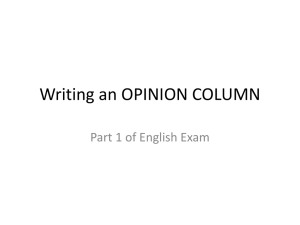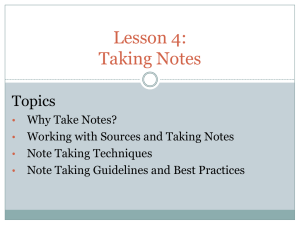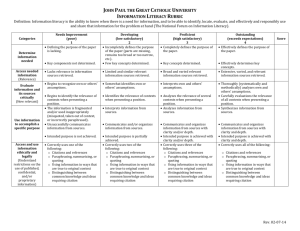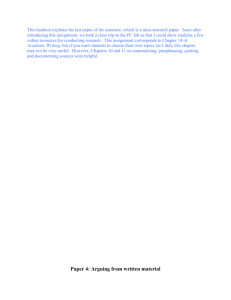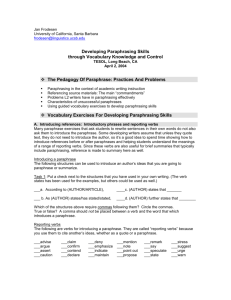QUOTING, SUMMARIZING, AND
advertisement
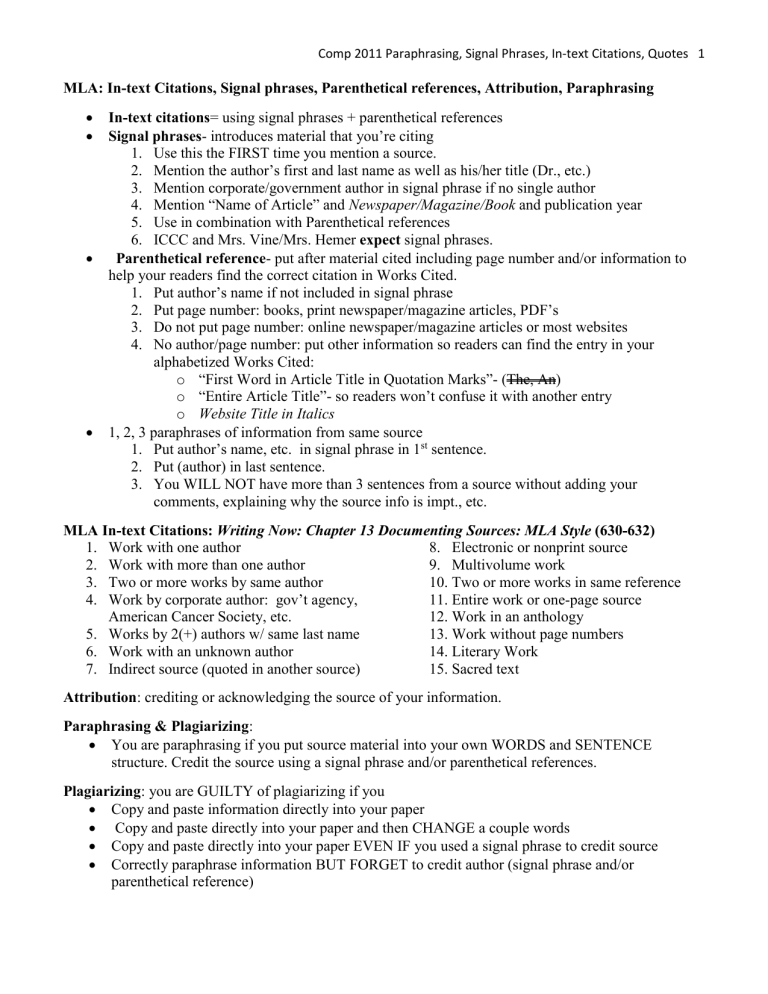
Comp 2011 Paraphrasing, Signal Phrases, In-text Citations, Quotes 1 MLA: In-text Citations, Signal phrases, Parenthetical references, Attribution, Paraphrasing In-text citations= using signal phrases + parenthetical references Signal phrases- introduces material that you’re citing 1. Use this the FIRST time you mention a source. 2. Mention the author’s first and last name as well as his/her title (Dr., etc.) 3. Mention corporate/government author in signal phrase if no single author 4. Mention “Name of Article” and Newspaper/Magazine/Book and publication year 5. Use in combination with Parenthetical references 6. ICCC and Mrs. Vine/Mrs. Hemer expect signal phrases. Parenthetical reference- put after material cited including page number and/or information to help your readers find the correct citation in Works Cited. 1. Put author’s name if not included in signal phrase 2. Put page number: books, print newspaper/magazine articles, PDF’s 3. Do not put page number: online newspaper/magazine articles or most websites 4. No author/page number: put other information so readers can find the entry in your alphabetized Works Cited: o “First Word in Article Title in Quotation Marks”- (The, An) o “Entire Article Title”- so readers won’t confuse it with another entry o Website Title in Italics 1, 2, 3 paraphrases of information from same source 1. Put author’s name, etc. in signal phrase in 1st sentence. 2. Put (author) in last sentence. 3. You WILL NOT have more than 3 sentences from a source without adding your comments, explaining why the source info is impt., etc. MLA In-text Citations: Writing Now: Chapter 13 Documenting Sources: MLA Style (630-632) 1. Work with one author 8. Electronic or nonprint source 2. Work with more than one author 9. Multivolume work 3. Two or more works by same author 10. Two or more works in same reference 4. Work by corporate author: gov’t agency, 11. Entire work or one-page source American Cancer Society, etc. 12. Work in an anthology 5. Works by 2(+) authors w/ same last name 13. Work without page numbers 6. Work with an unknown author 14. Literary Work 7. Indirect source (quoted in another source) 15. Sacred text Attribution: crediting or acknowledging the source of your information. Paraphrasing & Plagiarizing: You are paraphrasing if you put source material into your own WORDS and SENTENCE structure. Credit the source using a signal phrase and/or parenthetical references. Plagiarizing: you are GUILTY of plagiarizing if you Copy and paste information directly into your paper Copy and paste directly into your paper and then CHANGE a couple words Copy and paste directly into your paper EVEN IF you used a signal phrase to credit source Correctly paraphrase information BUT FORGET to credit author (signal phrase and/or parenthetical reference) Comp 2011 Paraphrasing, Signal Phrases, In-text Citations, Quotes 2 Raiders Research Handbook (Student Tab of East Sac Web) SECTION 3: QUOTING, SUMMARIZING, AND PARAPHRASING How are quoting, summarizing, and paraphrasing different? QUOTING Quoting is when you use an author’s exact words. Cite quotations and use “quotation marks.” SUMMARIZING Summaries are a shortened or abbreviated version of an author’s thoughts. While you write summaries in your own words, you do not change the meaning or add your interpretation. Always cite summaries. PARAPHRASING When you paraphrase information, you restate an author’s ideas in your own words and sentence structure. You should not just alter a couple of words nor should you change the meaning or add your interpretation. Paraphrases are about the same length as the original text. Always cite paraphrases. Should I paraphrase or quote? In research papers, you should quote from a source to show that an authority supports your point to present a position or argument to critique or comment on to include especially moving or historically significant language to present a particularly well-stated passage (meaning would be lost/changed if paraphrased or summarized) You should summarize or paraphrase when what you want from the source is the idea expressed, and not the specific language used to express it you can express in fewer words what the key point of a source is “Paraphrasing vs. Quoting—Explanation.” The Writing Center Writer’s Handbook. 2006. UW-Madison Writing Center. 10 Sept. 2007 <http://www.wisc.edu/writing/Handbook/QPA_PorQ.html> How much of my paper can come from quotations, summaries, and paraphrasing? No more than 10% of your entire paper should be quoted material. Quotes, Paraphrasing, and Summarizing together may not exceed 30-33% of the completed paper. Quoting Tips Add direct quotations only when the author’s words are truly memorable or to introduce or end your paper. including the exact punctuation. Also, write down the works cited information immediately. Attribute them to the author. es from the left margin. Comp 2011 Paraphrasing, Signal Phrases, In-text Citations, Quotes 3 Paraphrasing Tips: A Bridgewater College Writing Center Handout What Is a Paraphrase? A paraphrase is a rewording of another writer's text, explanation, argument, or narrative. It is about the same length as the original, but is substantially different in wording and sentence structure. Why Paraphrase? If your purpose is one of the following, you may wish to paraphrase a portion of a text: or a Bible verse or a speech from a play by Shakespeare); present an opposing point of view that you wish to refute. How to Paraphrase a Text marks. Following the author’s sentence structure, even if you use alternative wording, is considered plagiarizing. ot use a direct quotation from the source. are presenting someone else’s ideas with wording like “H. H. Smith argues that . . .” or “According to medical researcher Donald Smith, . . .” or “Smith also claims that . . .”. Summarizing Tips: A Bridgewater College Writing Center Handout What Is a Summary? A summary is a shortened version of another's text, explanation, argument, or narrative. It includes all of the main points of the original but reduces the detail of the original. Why Summarize? If your purpose is one of the following, you may wish to summarize a whole text or a portion of a text: ; How to Include Summaries in Your Text wording like “H. H. Smith argues that . . .” or “According to medical researcher Donald Smith, . . .” or “Smith also claims that . . .”. each paragraph of the original text. Then delete any ideas that don’t seem to be central to the argument. One example of this might be a full paragraph that develops one particular illustration of the point the author is making; your summary would include the point but not the illustration. you have gotten the main idea of each paragraph. If the author consistently uses topic sentences, use them as clues to the structure of his or her argument as a whole. Remember that a topic sentence can appear anywhere in a paragraph—beginning, middle, or end. ell as your own word choice. Adapted from: http://www.bridgewater.edu/StudentServices/WritingCenter/ ResourcesForStudents

